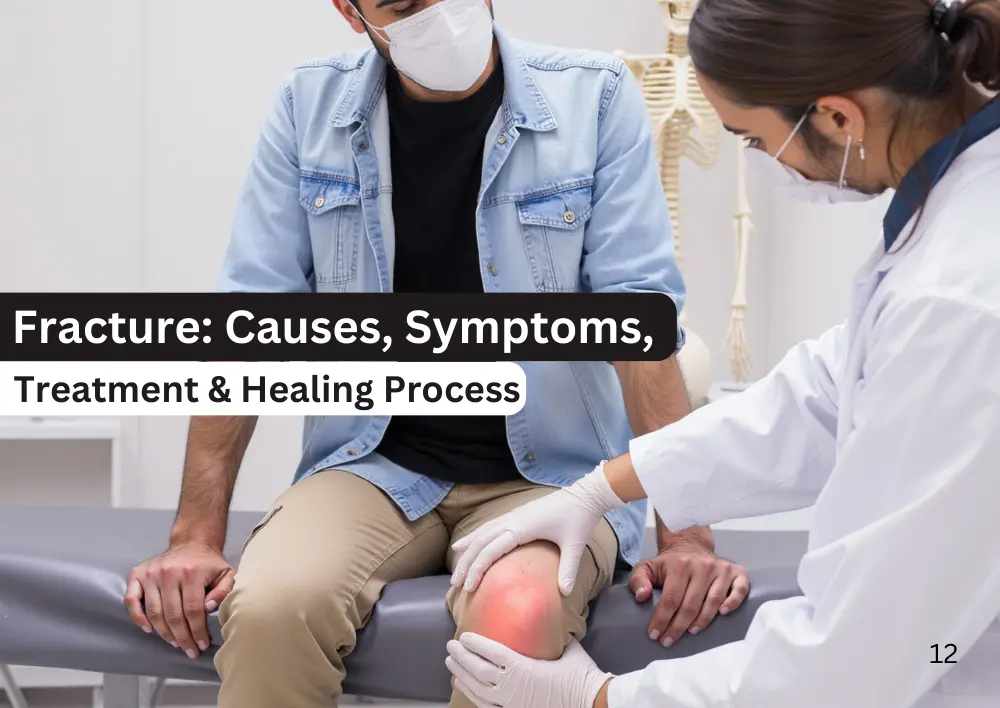Fracture: Causes, Symptoms, Treatment & Healing Process
Summary: A fracture is a break in a bone caused by trauma, medical conditions, or repetitive stress. It can range from a minor crack to a complete break. The treatment depends on the severity and type of fracture. Proper care is essential for optimal healing and to prevent complications.
Overview
Fractures, commonly known as broken bones, are a significant medical concern that affects people of all ages. However, studies say that it is more common in youth and the elderly population. Understanding different types of fractures, their symptoms, causes, and treatment options can help in effective recovery. In this blog, the leading orthopaedic doctor in gurgaon provides insight into the fracture, its causes, symptoms, and healing process.
Fracture Definition
A fracture refers to any break in a bone, ranging from small hairline cracks to severe breaks that pierce the skin. It can be caused by external force, diseases like osteoporosis, or excessive strain on the bone.
Types of Fracture
Fractures are classified based on their severity, pattern, and cause. Some common types include:
-
Closed Fracture: Also known as a simple fracture, In this type of fracture, the bone breaks but does not penetrate the skin.
-
Open Fracture: Also known as a compound fracture. In which, a bone pierces through the skin, increasing infection risk.
-
Comminuted Fracture: The bone shatters into multiple pieces.
-
Greenstick Fracture: An incomplete fracture where the bone bends but does not fully break.
-
Stress Fracture: A minor bone crack caused by continuous strain or repetitive impact.
-
Pathological Fracture: Occurs due to weakened bones from conditions like osteoporosis or cancer.
Symptoms of Fracture
The common signs of a fracture include:
-
Severe pain at the injury site
-
Swelling and bruising
-
Visible deformity or misalignment
-
Difficulty moving the affected area
-
Tenderness or numbness
-
In open fractures, the bone may be visible through the skin.
Fracture Causes
Fractures occur when the bone is subjected to extreme force, pressure, or stress beyond its capacity to withstand. Several factors contribute to bone fractures, including:
1. Trauma:
One of the most common causes of fractures is trauma, which can occur due to:
-
Accidents: Road traffic accidents, workplace injuries, or household mishaps can lead to severe bone fractures.
-
Falls: Slipping on wet surfaces, falling from heights, or tripping over objects can cause broken bones, especially in older adults.
-
Sports Injuries: High-impact sports like football, basketball, or gymnastics increase the risk of fractures due to sudden movements, collisions, or falls during play.
2. Overuse or Repetitive Stress
-
Repetitive activities can weaken bones over time, leading to stress fractures.
-
Common in athletes, dancers, and military personnel, these fractures develop slowly due to continuous strain on specific bones, such as those in the legs or feet.
-
Running, jumping, and excessive weightlifting without adequate recovery time can increase the likelihood of stress fractures.
3. Medical Conditions
Several underlying health conditions can compromise bone strength, making fractures more likely:
-
Osteoporosis: A condition that reduces bone density, making bones brittle and more susceptible to fractures, especially in older adults.
-
Bone Cancer: Tumors within the bone weaken its structure, increasing the risk of spontaneous fractures.
-
Infections: Certain infections, like osteomyelitis, can damage bone tissue and lead to fractures.
-
Genetic Disorders: Conditions such as osteogenesis imperfecta (brittle bone disease) result in fragile bones that break easily.
4. Nutritional Deficiencies
A lack of calcium and vitamin D can significantly weaken bones, making them more prone to fractures.
-
Calcium deficiency leads to decreased bone density, increasing fragility.
-
Vitamin D deficiency affects calcium absorption, further impairing bone strength.
-
Poor dietary habits, malnutrition, and inadequate sun exposure can contribute to weaker bones, particularly in children, older adults, and individuals with certain medical conditions.
By understanding these risk factors, individuals can take preventive measures, such as maintaining a healthy diet, engaging in regular exercise, and seeking medical advice for bone-related conditions.
Can a Fracture Heal on Its Own?
Some minor fractures, such as hairline fractures, can heal on their own with rest and limited movement. However, most fractures require medical attention to ensure proper alignment and healing. Without treatment, improperly healed fractures can lead to deformities, chronic pain, and mobility issues.
When Fractures Don’t Heal?
In some cases, fractures do not heal properly due to various factors, leading to nonunion or delayed union. Conditions that may affect fracture healing include:
-
Inadequate blood supply to the fractured area.
-
Infections at the fracture site.
-
Improper immobilization of the bone.
-
Medical conditions such as diabetes, osteoporosis, or smoking habits.
-
Severe trauma leads to bone loss.
How does Fracture heal?
Bone healing is a natural process where the body repairs the break by generating new bone tissue. The process depends on several factors, including age, overall health, type of fracture, and proper medical intervention.
Fracture Healing Stages
Fracture healing occurs in four stages:
-
Inflammatory Phase: The body responds to injury with inflammation, triggering blood clot formation around the fracture.
-
Soft Callus Formation: Cartilage begins to form, bridging the broken bone ends.
-
Hard Callus Formation: The cartilage hardens into new bone tissue.
-
Remodeling Phase: The newly formed bone reshapes to restore its original structure and strength.
Fracture Treatment
The treatment of fractures varies depending on the type, location, and severity of the break. The primary goal of treatment is to ensure proper healing, restore function, and minimize complications. The following are the most common treatment methods for fractures:
1. Immobilization
Immobilization is important for keeping the fractured bone in place while it heals. This process helps prevent further injury and ensures proper alignment. Different methods of immobilization include:
-
Casts: Plaster or fiberglass casts are commonly used to encase the broken bone, providing support and stability during healing.
-
Splints: Unlike casts, splints do not fully encircle the limb but provide partial support, allowing for swelling to decrease. They are often used for minor fractures or as a temporary measure before casting.
-
Braces: Used for less severe fractures, braces help restrict movement while allowing limited flexibility to prevent stiffness.
2. Medication
Pain management is important in fracture treatment, as broken bones can cause significant discomfort. Common medications prescribed include:
-
Pain relievers: Over-the-counter painkillers like ibuprofen or acetaminophen help reduce pain and inflammation.
-
Anti-inflammatory drugs: These medications help control swelling and discomfort in the affected area.
-
Antibiotics: In cases of open fractures where the bone pierces the skin, antibiotics are given to prevent infections.
-
Calcium and vitamin D supplements: These are sometimes prescribed to help in faster bone healing, especially for individuals with osteoporosis or nutritional deficiencies.
3. Reduction (Realignment of Bone Fragments)
When a bone is displaced due to a fracture, it needs to be realigned to heal correctly. There are two types of reduction procedures:
-
Closed Reduction: This is a non-surgical procedure where the doctor manually manipulates and realigns the broken bone before applying a cast or splint.
-
Open Reduction: If the bone cannot be realigned manually, surgical intervention may be required to reposition the bone fragments.
4. Surgery (Internal and External Fixation)
For severe fractures that cannot heal properly with immobilization alone, surgical procedures may be necessary. These include:
-
Internal Fixation: Metal plates, screws, rods, or pins are surgically placed to hold the bone fragments together. This method is often used for complex or weight-bearing fractures.
-
External Fixation: In some cases, a stabilizing frame with metal pins and screws is attached externally to keep the bone in place while it heals. This is used when internal fixation is not feasible or when there is extensive soft tissue damage.
5. Physiotherapy and Rehabilitation
After the bone has healed, rehabilitation plays an important role in restoring function, mobility, and strength. This includes:
-
Range-of-motion exercises: Gentle movements help prevent stiffness and improve flexibility.
-
Strengthening exercises: Gradual weight-bearing activities help rebuild muscle strength and support the healed bone.
-
Balance and coordination training: Helps patients regain stability, especially after lower limb fractures.
-
Pain management techniques: Therapies such as heat therapy, ultrasound, and electrical stimulation may be used to reduce pain and promote healing.
Proper treatment and rehabilitation ensure a full recovery, allowing individuals to return to their normal activities safely.
Conclusion:
Fractures are common but require timely medical attention for proper healing. Understanding their causes, symptoms, and treatments can aid in faster recovery and prevent complications. If you experience symptoms of a fracture, consult an ortho doctor near you at Miracles Healthcare to seek medical care immediately for accurate diagnosis and treatment.
Frequently Asked Questions
Yes, fractures often cause swelling due to inflammation, bleeding, and fluid buildup around the injured bone.
An oblique fracture is a slanted break that occurs diagonally across the bone.
Fracture blisters can be serious as they indicate significant soft tissue damage and increase the risk of infection and delayed healing.
Hairline fractures (stress fractures) typically heal the fastest, usually within 6-8 weeks, due to minimal bone displacement.
Yes, a fracture can cause fever if there is an infection, internal bleeding, or an inflammatory response in the body.














Was the information useful?
0 0